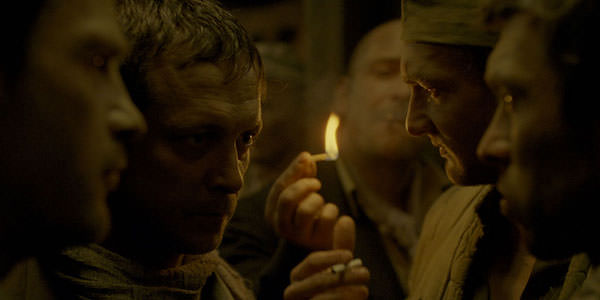
An immersion in Auschwitz during the mass murder frenzy of October 1944, when the gassing of Hungarian Jews had been nearly completed, Son of Saul—a first feature by the French-Hungarian director László Nemes—is not a movie to recommend lightly.
It is also, as a fictional film that depicts, in what might almost be a single endless take, a prisoner’s single-minded quest to give a boy who could be his son a Jewish burial, a movie that strains credulity. But then so does Auschwitz. “The world into which one precipitated was terrible,” Primo Levi wrote, “but also indecipherable: It did not conform to any model.” It was, in the deepest, most dreadful sense of the word, absurd.
Son of Saul can be taken as a fable (a feeble word for so visceral an experience) that ponders the nature of redemption under the most extreme circumstances. Nevertheless, it is far from Oscar-winning crowd-pleasers like Schindler’s List orLife Is Beautiful. In a way, it is their antithesis. Son of Saul may also win an Oscar (it has already been nominated for a Golden Globe), but, taking as its subject the moral nightmare of Jewish collaboration, the salvation it offers is more like the idea of redemption where none is possible.
The protagonist, Saul Ausländer (played with expressionless determination by the poet Géza Röhrig, a Hungarian native of the Bronx), is a member of the Auschwitz “special command unit” or Sonderkommando—one of the hundreds of mainly young, mostly Jewish men whose lives were spared for several months so that they could perform the filthiest of the Nazi dirty work. It was their task to clean out the gas chamber, relieve the dead of their gold fillings, shovel the bodies into the crematoria, and dispose of their ashes.
Why did these doomed men not kill themselves first? As Albert Camus began The Myth of Sisyphus, his book-length essay on the absurd: “There is but one truly serious philosophical problem, and that is suicide.” Some did, but the will to live is not necessarily a choice. Levi, who considered the creation of the Sonderkommando to be the Nazis’ “most demonic crime,” ponders their isolation (“deprived of even the solace of innocence”) and also their opacity. Notwithstanding the testimony that has been found or given, he wrote, “We have found it difficult, almost impossible, to form an image for ourselves of how these men lived day by day, saw themselves, accepted their condition.”
Most appallingly, these slaves who stoked the annihilation machine were used to herd dazed and terrified fellow Jews from the transport trains into the showers.Son of Saul more or less begins with this process, perhaps the second most awful thing imaginable, but ends, with the sound of pounding on the gas chamber door, without dramatizing the worst.
Son of Saul’s brief explanatory title refers to the men of the Sonderkommando as the “bearers of secrets.” Levi uses a similar term in his final book The Drowned and the Saved. Claude Lanzmann interviewed one of the very few surviving Sonderkommando, Filip Müller, in Shoah. When I interviewed Lanzmann in 1985, he told me that he considered Müller as a “saint.” Saul Ausländer is not that, but he might be described as a holy fool, and, like some saints, he is possessed by a sense of mission.
Nemes and his co-writer Clara Royer credit Voices From Beneath the Ashes (an anthology of Sonderkommando testimony, not translated into English) as their source, but its inspiration might well have been the second chapter of The Drowned and the Saved. Here, Levi not only discusses the Sonderkommando, among other Jewish collaborators, but recounts the “exceptional, unique” story of the teenaged girl who somehow survived the gas chamber and describes the doomed Sonderkommando revolt of Oct. 7, 1944—the two legendary historical events that structure Son of Saul.
After a young boy (briefly) lives on, Saul manages to delay the child’s autopsy, then seeks to find a rabbi who can officiate over the child’s burial. (He also tries to find out, in vain, if the transport was from Hungary—the first indication that the miracle child is not his actual son.) Saul’s crazed search maps the perimeters of the Sonderkommando world—separate from the rest of the camp, the genocide’s “backstage” in the British film critic Jonathan Romney’s apt formulation. The self-anointed father’s stubborn irrational passion also serves to identify the Sonderkommando hierarchy, something the viewer has to puzzle out on the fly and something, like a secret, that can never truly be known.
Tumult is constant, and so is babel. Hungarian, German, and Yiddish are mixed with concentration-camp slang. Throughout, Saul demonstrates super- (or is it sub?) human powers of concentration. Totally focused on survival, he seems hyper-alert yet robotic. Is his an animal intelligence, or is it one in which a human spirit has been rekindled? Even in the fiery pit of hell, Saul searches for a rabbi, grabbing a likely looking man, just off a transport, utterly bewildered and headed for the showers: “You’ll help me bury my son!”
***
Fascinating from beginning to end, Son of Saul is a movie that, among other things, tries to evoke the sensation of being terrorized every moment of every day. (SeeMaus II, chapter 2 with Art kvetching to his therapist that he can’t begin to imagine what Auschwitz “felt like.”) Here we must ponder the movie’s artifice.
Son of Saul is highly stylized. The format is boxy and the depth of field often shallow. There is little, if any, use of conventional cross-cutting. Saul, who seems to be in virtually every shot, is tightly framed and often in close-up—particularly when he is motion—a strategy developed by the Dardenne brothers in their neo-neorealist movies to heighten the protagonist’s situation. The idea would seem to be the replication of Saul’s tunnel vision. It also allows the movie to suggest more horror than it shows. At the same time, the sound mix is disorienting and clamorous.
Nemes served as an assistant to the reigning maestro of Hungarian cinema, Béla Tarr, but he is also a born filmmaker. (Not just figuratively but literally. His father, András Jeles, was among the most interesting Hungarian directors of his generation and also among the first to directly address the deportation of Hungarian Jews in his 1990 film Why Wasn’t He There?) And his filmmaking has broken a taboo.
As disturbing and resistant to representation as Nemes’ subject is, it is understandable that some critics have been put off by his apparent aestheticism. On the other hand, some found the movie overly naturalistic. At the New York Film Festival press conference I attended, a man objected to his use of color—as ifSchindler’s List had determined that the Holocaust could only be filtered through the abstraction of black and white.
It is not surprising that Son of Saul stirred strong feelings at Cannes—where it was in competition and won the Grand Prix (runner up to the Palme d’Or). Citing Elie Wiesel’s koan that “a novel about Auschwitz is either not a novel or not about Auschwitz,” the Austrian journalist Stefan Grissemann denounced Son of Saul as a “willfully obscene thriller.” I would suggest that it is rather a deliberate—and possibly absurd—attempt to incorporate moral philosophy into an action film.
Reporting in the New York Times, Manohla Dargis acknowledged Nemes’ “technical virtuosity” even as she characterized his movie as “radically dehistoricized” and “intellectually repellent” in its focus on a single figure in the midst of unspeakable horror. Whether or not this isolation was the natural state of an Auschwitz prisoner (“a thousand sealed-off monads, and between them a desperate covert and continuous struggle,” per Levi), Saul Ausländer’s separation from the rest of humanity might be termed the Sonderkommando Condition. Levi quotes one: “Doing this work one goes crazy on the first day or gets accustomed to it.”
It is not for nothing that the filmmakers give their anti-hero a name translatable as “stranger.” (“A world that can be explained even with bad reasons is a familiar world,” Camus writes in The Myth of Sisyphus. “But on the other hand, in a universe suddenly divested of illusions and lights, man feels an alien, a stranger.”) The significance of Saul’s crazy, compelling need to give his “son”—one dead Jew out of the exterminated millions—the recognition of a proper funeral is his attempt to transcend or at least give meaning to his solitude. Hence the haunting pseudo resurrection that causes the fool to at last break out in a grin of mindless joy.
Coinciding with the foredoomed revolt that is only launched when the men of the Sonderkommando understand they are to be liquidated, Saul’s mission is an absurd quest in an incomprehensible charnel house. “You failed the living for the dead,” one of the organizers tells him. But “we are already dead,” Saul maintains. He may be a meshuganeh but he raises the question whether blowing up the cremo is any less inspirational (or more irrational) than adopting a dead child and endeavoring to escape with the child’s corpse in his arms.
Both the revolt and Saul’s delusional attempt at tikkun unfold against a backdrop of divine indifference. The film ends as it began in the surrounding woods outside Auschwitz, incongruously peaceful and improbably green for October. Yet Son of Saul is not utterly devoid of hope. Close attention to the orchestrated chaos shows that, as heedless as he is, Saul is repeatedly spared by the selfless actions (intentional and otherwise) of some, even as his fanaticism directly or indirectly causes the death of others.
Increasingly allegorical but never less than visceral (visceral and thoughtful), Son of Saul is a film about the aftermath of a miracle and then a series of miracles that, in its brutal tact, compassion, and intelligence, is something of a miracle itself.





